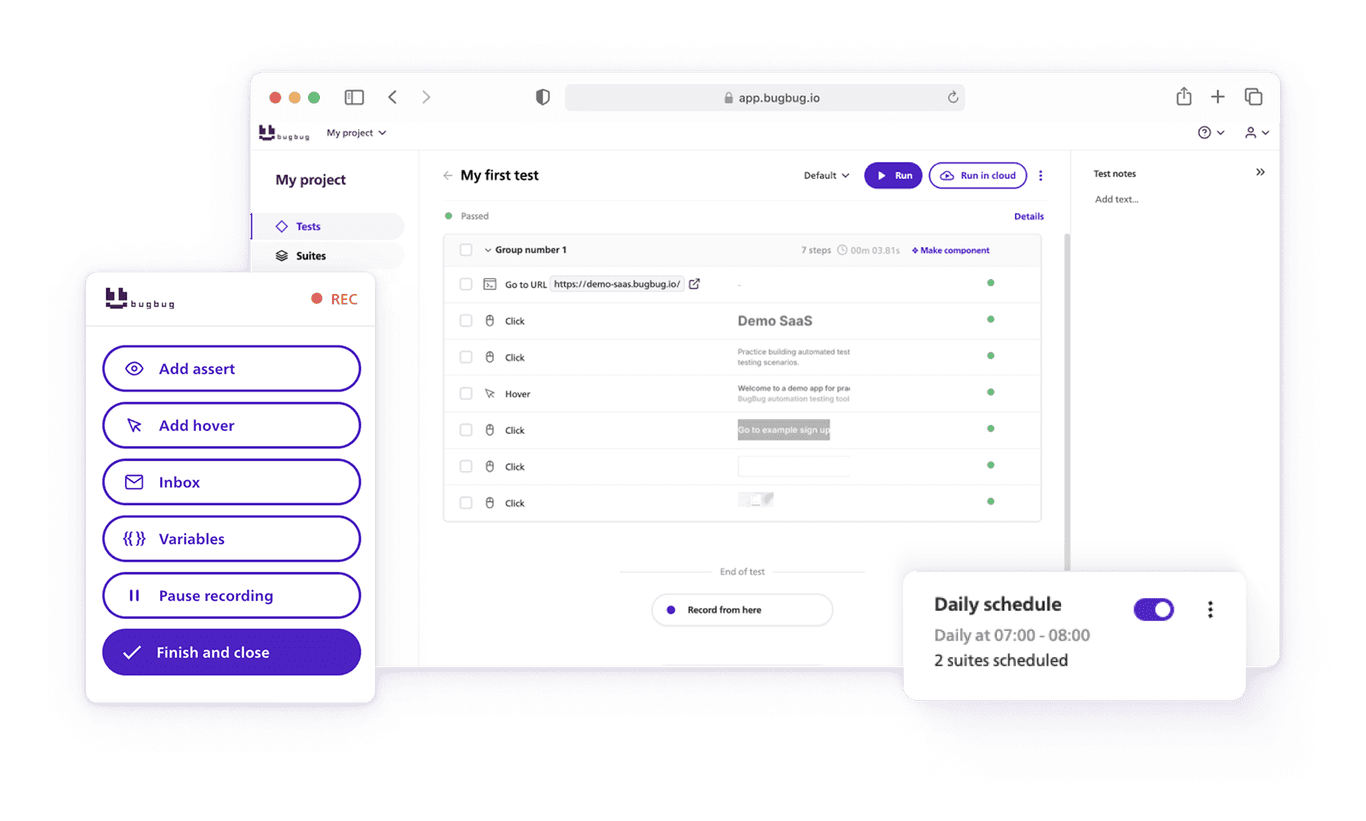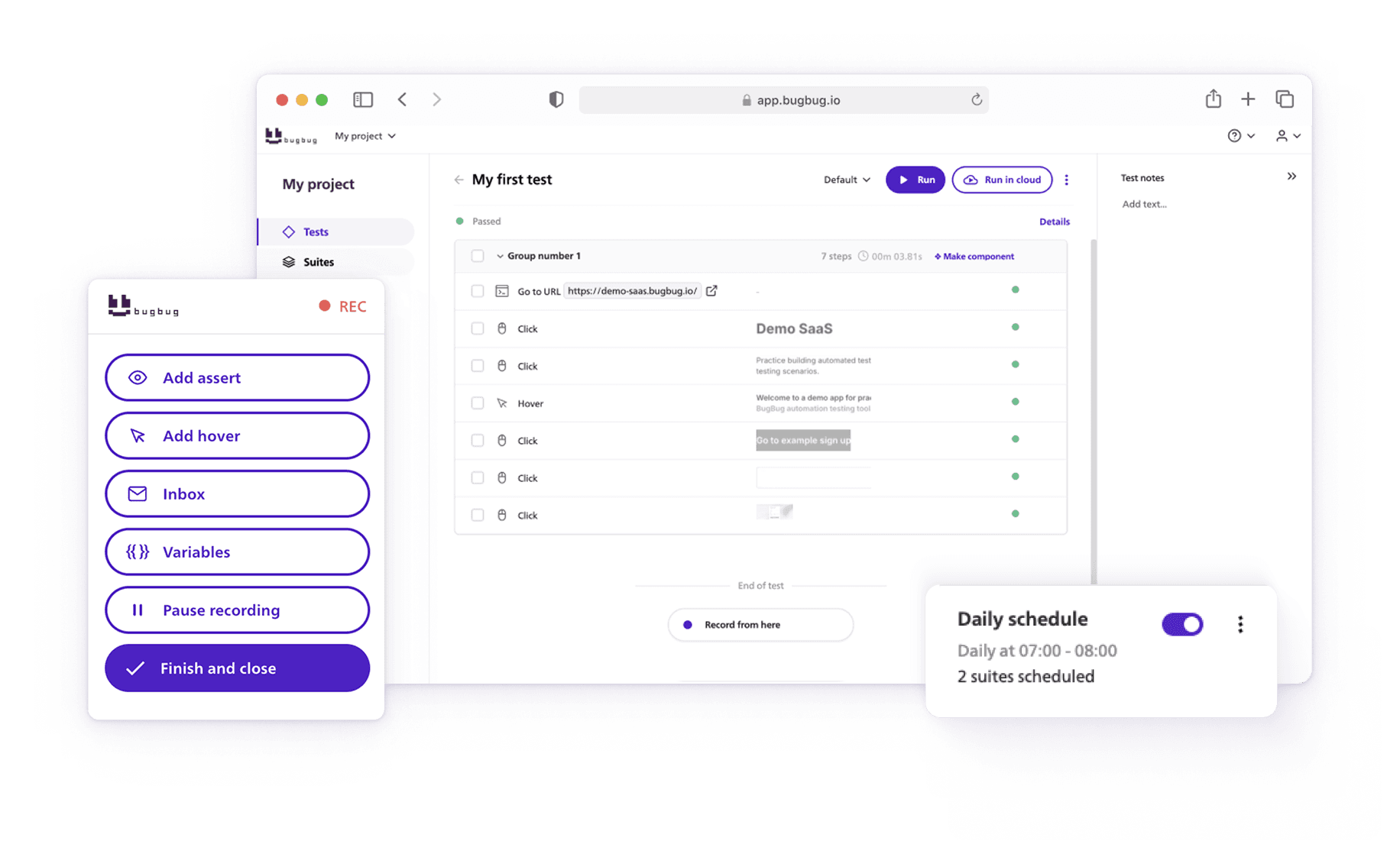🤖 Summarize this article with AI:
💬 ChatGPT 🔍 Perplexity 💥 Claude 🐦 Grok 🔮 Google AI Mode
- 🎯 TL;DR
- Why Coverage Matters in E2E Testing
- What Does “Enough Coverage” Really Mean?
- How to Measure Test Scenario Coverage
- Signs You May Have Too Few (or Too Many) Tests
- Essential Scenarios Every E2E Suite Should Include
- Balancing Coverage with Maintainability
- How Tools Like BugBug Help You Assess Coverage
- Conclusion: Striking the Right Balance
🎯 TL;DR
✅ E2E coverage is about confidence, not completeness — you can’t test every path, but you must cover critical workflows that matter most to users and the business.
📊 Measure coverage by mapping “money paths,” prioritizing by risk, and tracking heuristics like regression detection speed and % of critical flows tested.
⚖️ Balance is key — too few tests leave gaps, while too many create bloat, flaky failures, and slow CI/CD pipelines.
🧩 Focus on essential scenarios like authentication, payments, core transactions, third-party integrations, and error handling.
Check also:
Check also:
Why Coverage Matters in E2E Testing
Every QA engineer and developer has faced the sinking feeling of a bug slipping into production despite having “tests in place.” Often, it’s not that the tests were poorly written — it’s that they didn’t cover the right scenarios.
End-to-End (E2E) testing is supposed to be our safety net, ensuring that real-world user workflows hold together across frontend, backend, databases, and integrations. But there’s a constant tension:
- Too few tests → blind spots in critical flows, leading to costly production incidents.
- Too many tests → bloated suites that slow CI/CD pipelines and frustrate teams.
So how do you know if your E2E tests cover enough scenarios? That’s the question this article tackles. We’ll break down what “enough coverage” actually means, how to measure it, and how to balance confidence with speed.
💡 Check also: Codeless automation testing tools compared
What Does “Enough Coverage” Really Mean?
First, let’s clear up a common misconception: there is no such thing as 100% meaningful E2E coverage. You can’t test every possible user journey, device, or integration state. And even if you could, the cost of maintaining that level of coverage would cripple your delivery speed.
Instead, “enough” should mean:
- You’ve identified the most critical workflows for your business and users.
- Your tests give you confidence that those workflows won’t break after a release.
- Your coverage is lean and sustainable, not redundant or flaky.
Think of it this way: test coverage is about confidence, not completeness.
How to Measure Test Scenario Coverage
Measuring E2E coverage isn’t as straightforward as code coverage for unit tests, but there are practical ways to assess it:
Map Critical User Flows
- What are the “money paths” in your app? For an e-commerce platform, it’s browsing → cart → checkout → payment. For a SaaS product, it might be signup → onboarding → subscription management.
- Start by making sure these workflows are fully tested.
Use Risk-Based Prioritization
- Focus on scenarios where failure would cause maximum impact — lost revenue, compliance breaches, security risks.
- Example: A minor profile picture update failing is tolerable. Checkout failures are not.
Track Metrics and Heuristics
- % of business-critical flows covered.
- Time it takes to detect regressions after code changes.
- Ratio of automated vs. manual checks in your release process.
Example heuristic: If bugs repeatedly appear in production in areas you don’t have E2E tests for, your coverage isn’t enough.
Modern teams often visualize this as a matrix: features vs. risk vs. coverage. This helps identify gaps quickly without obsessing over vanity metrics.
Start e2e tests in 5 minutes
Test easier than ever with BugBug test recorder. Faster than coding. Free forever.
Get started
Signs You May Have Too Few (or Too Many) Tests
Signs you have too few tests:
- Bugs keep slipping into production on obvious user journeys.
- Stakeholders often ask: “Was this even tested?”
- High reliance on manual testing for critical flows.
Signs you have too many tests:
- Your CI/CD pipeline takes hours to run because of bloated automation.
- You see frequent flaky test failures, especially on overlapping flows.
- Developers are reluctant to update tests because maintenance is overwhelming.
The sweet spot is lean but comprehensive: your suite covers what matters most without duplicating effort or creating bottlenecks.
Essential Scenarios Every E2E Suite Should Include
While exact coverage depends on your product, there are universal must-have scenarios:
- Authentication & Onboarding
Login, signup, password reset. Broken authentication can lock out every user. - Core Business Transactions
Checkout and payment for e-commerce. Subscription creation and renewal for SaaS. Funds transfer for banking apps. - Key Integrations
Email notifications (confirmations, resets). Third-party APIs (payment gateways, shipping providers). - Error Handling
Failed payments, validation errors, expired sessions. Users judge reliability by how gracefully errors are handled.
👉 Example: For an e-commerce app, testing checkout is far more valuable than testing whether a user can update their profile picture. Prioritize what drives value and risk.
Balancing Coverage with Maintainability
It’s tempting to chase higher numbers, but more tests don’t automatically mean better quality. In fact, poorly designed or overly detailed E2E tests often cause more pain than they solve.
Tips for balancing coverage:
- Avoid test bloat: Don’t write separate tests for trivial UI details that can be handled by unit/UI tests.
- Focus on outcomes: Test whether the user achieves their goal (successful checkout), not every click.
- Optimize test runs: Keep a small regression set for every commit, and run extended suites on a schedule (e.g., nightly).
- Kill flaky tests: If a test is unreliable, fix it or remove it — flaky coverage is worse than no coverage.
In practice, the healthiest test suites are smaller than you’d expect but highly reliable.
How Tools Like BugBug Help You Assess Coverage
Choosing the right tooling makes coverage easier to achieve and maintain. This is where lightweight automation platforms like BugBug come in:
- Visual workflow clarity: BugBug lets you design and visualize test flows, making it obvious if a critical path is missing.
- Editing & debugging: You can insert missing steps anywhere in a flow and even “rewind” tests to debug — perfect for refining coverage.
- Lightweight automation: No Selenium grids, Docker setups, or complex environments required. BugBug works out of the box, so teams can cover more ground with less overhead.
- CI/CD & Slack integrations: Ensure coverage checks are part of your delivery pipeline and team communication.
In other words, BugBug removes the typical barriers that make broad E2E coverage impractical.
Conclusion: Striking the Right Balance
So, how do you know if your E2E tests cover enough scenarios?
- You’ve mapped and tested your critical user flows.
- You’ve used risk-based prioritization to focus on what really matters.
- Your suite gives you confidence without dragging down delivery speed.
Remember: E2E coverage isn’t about quantity — it’s about confidence. The goal is to prevent catastrophic failures in production, not to test every pixel or permutation.
By combining thoughtful prioritization with the right tools, like BugBug, you can strike the balance: lean, reliable coverage that safeguards user trust and keeps your team moving fast.
Happy (automated) testing!



